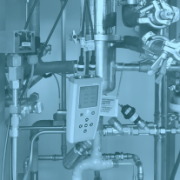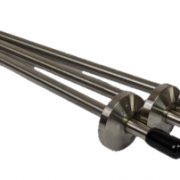Steam Quality Testing – Beyond the Basics

Steam Quality test : Non condensable gas test
Where does the NC gases come from? The primary source of the gas is the feed water. Gases are naturally entrained in the feed water. When the water is pumped into the boiler, the gases are then liberated and enter the steam distribution system.Other sources are:- Compressed air leaking into the steam distribution pipe work. Air being pumped in via faulty boiler water feed pumps.
What you need to understand
A very common misconception is that the amount of gas in the steam is a % of the volume of steam. It is not, it is % of the mass of the steam. To establish the mass of the steam you need to turn it back into water. A value of 2% NC gas is equivalent to 2ml of gas in 100ml of condensed steam. As mentioned above the gases are liberated from the feed water when it is pumped into the boiler. So it is vitally important that you test for an extended period of time to understand the characteristics of the system.
How it’s tested for:-
The simplest system is to condense the steam and separate out the gas from the water using gravity. As air is lighter than water you can separate out the gases from the water by letting the gas displace water in a burette and collect the rest of the water so it can be measured. The EN285 system test rig uses that method but is extremely limiting due to the very short test window it imposes on you. The NC gas testing equipment TJB Systems Ltd supplies enables a very much longer test window. This is important as the NC gases are very rarely evenly distributed over time in a steam supply.
Steam Quality test : Dryness
Where does the water in the steam come from? The simple answer is everywhere.
- The Boiler When a boiler is in operation, the feed water is heated to the point where the water at the top turns from a liquid to a gas. At this point it is deemed to be 100% dry saturated steam. However the action of the bubbles of steam bursting on the water surface releases small droplets and these droplets are carried out along the steam distribution system.
- The walls of the steam piping. As steam loses energy it returns back to water. This happens on every surface colder than the steam inside it. Normally this water is drained off and out of the piping. However the water on the walls of the piping will shed off into the steam flow, especially during high demand on the steam.
What you need to understand
When it comes to actually working out how much water there is in the steam, it is not actually that simple. The density of the water to the steam is extremely small. When you hear the term “5% water to steam by mass”. You might think that if you had 1ltr (volume) of steam with a 5% dryness there would be 50 grams of water in there. This is in fact wrong. As the term is 5% by mass. Because water expands so much when it turns from water to steam. For example at regular atmospheric pressure, 1kg/1ltr of water will expand approximately 1700 times. So your 1 ltr of steam actually only weighs 0.000588kg or 0.588grams. That means the water droplets at 5% by mass would be 0.0294grams. By any standards that is very small and almost impossible to measure.Luckily there is a way to work out the dryness value without resorting to hyper accurate balances.
How it’s tested for
The system used in EN285 uses two properties of the steam, the energy contained in it and the weight.Procedure is:-
- Take a known volume of water
- Heat the water up a known amount
- Work out the amount of energy you would need to heat the water up by the known amount
- Workout how much steam by mass that would be required to deliver that energy
- Compare that value to the actual mass increase that was used to heat up the water. The Result is the % difference between expected and found
Steam Quality test : Superheat
Where does the superheat come from? There are 2 obvious ways to superheat steam.
- Add extra heat into the steam
- Reduce the pressure quickly For example if you have steam at 4 barg the temperature of the steam would be approximately 143oC. Now if you reduce that pressure through an orifice the temperature will not match the new pressure. The Superheat test was designed to detect this elevated temperature caused by a pressure reducer.
What you need to understand
The reality is the EN285 superheat test does not work. It very rarely gets above the local boiling point. In my 20+ years of steam testing I have only seen it fail the +25c limit once and that was on a factory steam line. It ran in excess of 7.5 barg and was not connected to any plant like a sterilizer. There are a few reasons why the test rarely goes above +15deg of the local boiling point. None of which I will cover here. Look out for an article on it later in the year.
How it’s tested for
The system described in EN285 is meant to enable you to measure the temperature of the expanded steam. It is designed to prevent the venturi effect drawing cool air in as the steam exits the pitot tube, thus measuring the potentially superheated steam temperature. Apart from my previous declaration about it not working, my only comment is that you need to be very careful when performing the test. YOU MUST wear gloves as the energy in the uncooled steam is very high and will suffer a burn very quickly.





